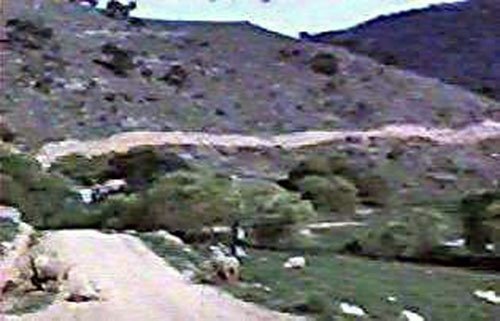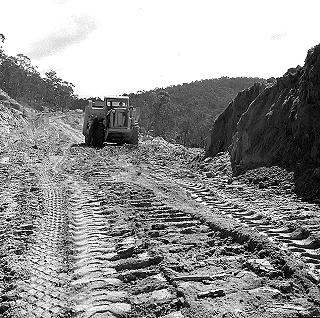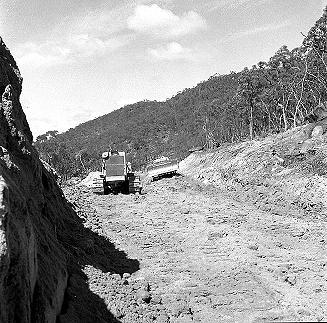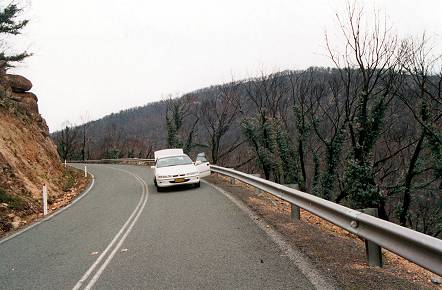One of the Ford Falcons easing past a washaway on the old track, heading for home after a day’s work.
Photo: Hamish Lindsay. Negative scan: Colin Mackellar.
More here.
The Apollo Road
The
Old Road
In
order to construct the tracking station, a temporary dirt road was built.
|
One of the Ford Falcons easing past a washaway on the old track, heading for home after a day’s work. Photo: Hamish Lindsay. Negative scan: Colin Mackellar. |
Mike Dinn writes –
“The original ‘Apollo Road’ went up the opposite side of the valley, after leaving the level part. I made that trip only once, as a visitor from Tid, but people like Hamish and John did it regularly.
And all the material for the station went up it. The building contractor’s (T.H. O’Connor) staff lived in a camp on that flat area to the right of the gate boom. Their huts ended up as shearer quarters at one of the farms you pass near the start of Apollo Road.”
Here’s one of the buildings mentioned above, near the start of Apollo Road.
Photo: Colin Mackellar, July 2019.
Hamish Lindsay writes –
“I well remember the trip to work up the old road – one day I left home at 7:00am and got to work at 10:00am.
Although we used to travel up in four wheel drives, some wanted to try taking the Falcons up and we would put chains on [see photo]. I can’t remember who took the photos. I remember we passed one car with its petrol feed pipe sticking out the side, ripped out by the sometimes frozen ground. It was winter.”
He also writes –
“The road we used to drive to work was supposed to be closed one day every year to legally keep it a private road, so on Friday 14 April 1967 the owner put a notice in the paper to say the road would be closed to the public on Saturday. This caused a stir at the station as we had to support an unmanned mission that weekend.
The story of this conflict appeared in all the daily newspapers. I was asked would I be prepared to stay on the site over the weekend but in the end station staff were allowed through; all other members of the public were stopped by a security guard at the entrance to the track.”
John Saxon writes –
“I remember that the old road used to be quite good provided it was graded regularly – but when it had been raining it was a different story!
During my time from October 1966 onwards, I don’t remember ever fitting chains – not sure that we had any by then. But it often took some very enthusiastic ‘bouncing’ by the rear passengers to get enough grip to make it to the top. A rather large young couple were much in demand for this procedure and we competed to take them home (and back in the next day) if the forecast was bad!”
|
A general scene of the car change point in the bottom of the valley, just over the creek. Updated scan: Colin Mackellar, 2020. |
|
Chains for the mud! Left to right: Len Litherland, Ian Anderson, Hamish Lindsay. Photographer unknown. Scans by Hamish Lindsay. |
See also these photographs
taken by Ian Hahn.
The New Road – “The Panos Freeway” – opened August 1967
The
temporary dirt road was just that – temporary. The sealed road now known
as “Apollo Road” was nicknamed the “Panos Freeway”. It was
the ‘new’ road from the last farmhouse up to the station.
 |
|
The Panos Freeway under construction can be seen in the distance, further up the hill from the temporary road. |
In 1968, Bruce Withey took this 8mm movie film of his drive the Honeysuckle Creek. Also on Vimeo. |
Hamish Lindsay writes –
“Panos was the contractor who built the road. We used to watch his dozers plugging away on the side of the hill for months.”
He also writes, “At the beginning of August 1967 it had been raining heavily and we were hoping the nice bitumen road would be finished to make our journey to the station safer, and to our relief when we arrived at the bottom of the hill on Monday 7 August we found a sign by the road saying ‘Drive slowly over the new work.’
The Panos Freeway was open for business and our journey to work was normalised.”
 |
 |
|
“The
Panos Freeway” under construction.
Photos by Hamish Lindsay.
|
|
Built through very steep granite countryside, the road would regularly be affected by boulders falling onto the road – and on at least one occasion a large section collapsed into the valley. On other occasions, cars slid off the road.
Hamish continues,
“On 11 May 1968 I was in the ditch taking a photograph of some rocks on the road and heard a crackling sound above me. I couldn’t see anything and moved on. Bruce Hamilton, the Admin Officer, drove past within the next half hour and told me of a huge rock on the road. When I went down to look – there was this huge boulder squatting right where I had been standing in the ditch!!
That sound I heard must have been the beginning of the slip. We had 93 mm of rain in 24 hours that day.”
John Saxon remembers –
“I was in the front passenger seat of one driven by Geoff Ruck – there were a bunch of sheep on the gravel road and we collected one, did some impressive rotating and slid over the edge. Went down a few 10s of metres and ended up balanced precariously on a large rock. Not sure who else was in the car but it might have been Bernard Smith.
I thought I was quite calm – but climbed out on the downhill side with the car teetering around above me!
Now that reminds me of another one – talk about the ‘can do – get to work at all costs’ spirit! Do you remember when the bitumen had got to just past the woolshed on the Naas side of Tharwa – just before the place where the Namadgi Visitor’s Centre is now, and there was quite a dip in the road. The road workers left several large piles of dirt in the middle of the road for the next day’s work.
Needless to say it chucked it down that night and next day the visibility was very poor in heavy rain. The inevitable happened and a car driven by (the guy who used to refill the cars? The world’s fastest reverse driver...) hit the first pile head on and buried itself almost up to the windscreen. Ken Staff was in the front passenger seat looking a bit dazed with a cut on his forehead. I think one of the ladies was having hysterics in the back seat – but the driver was waving all the other cars on with “Keep going! No Worries!”, etc.
Which reminds me of a certain Chief Engineer’s car ending up on top of a fence pole... The car that saw the road fall down the cliff....”
John Berry writes –
“I was in the car immediately behind the one that went over the side, on the dirt road section. We pulled over, and I saw Bernard Smith climbing out of a window. (The Falcon was on its side). Luckily nobody was hurt. I can’t remember who was in my car, but we were all shaken by the incident. That was in 1972.”
Road collapse, February 1971 –
Honeysuckle Creek made The Canberra Times when a section of the road to the station collapsed into the valley just after the station had supported Apollo 14.
February 1971 after the road slid into the valley. Photo: Hamish Lindsay. Scan from negative: Colin Mackellar |
|
February 1971. Staff going home after work about three hours after the road slid into the valley. Photo and text: Hamish Lindsay. |
|
And here’s Hamish’s photo and a report in The Canberra Times, February 1971. Scan: Danny Twomey. |
The road slip meant that the old track along the side of Deadman’s Hill had to be used while the road was repaired. This page from Ed von Renouard’s scrapbook documents using the old track to get to work during Apollo 14 support. |
|
All the cars that were trapped on the mountain on the day of the slip. The road slump is on the left of the picture. Photo: Hamish Lindsay. Scan: Colin Mackellar. |
|
The road was there! USB Engineer Mike Evenett (left) and Chief Engineer Bill Kempees inspect the damage the next day. This photo was featured in the the Manned Space Flight Network’s Technical Information Bulletin Volume 8, Number 8, for June 17 1971. Photo: Hamish Lindsay. Updated scan from Hamish’s 4x5 inch negative (2021): Colin Mackellar. |
|
Boulders across the road, February 1971. Photo: Hamish Lindsay. Scan from 4x5 inch negative: Colin Mackellar. |
|
Another photo of boulders across the road. Photo by Hamish Lindsay, scanned by Mike Dinn. |
|
Nevil Eyre writes, “You may remember seeing this old tin shack on Apollo Road. It was situated about 2 or 3km from the station. Many of the staff called it ‘The Honeysuckle Hotel’.” Photo: Rhelma Lawrence, Scan: Nevil Eyre. |
“Apollo
Road” today
 |
|
You wouldn’t normally park on a blind bend on Apollo Road – but the road was still closed as a result of the devastating January 2003 bushfires. (A ranger for Environment ACT very kindly escorted us up to the Honeysuckle site.) Note the regrowth on the blackened trees. Photo: Colin Mackellar, October 2003. |
In July 2019, the ACT Government erected a new sign at the start of Apollo Road. Click the image to see more photos. |